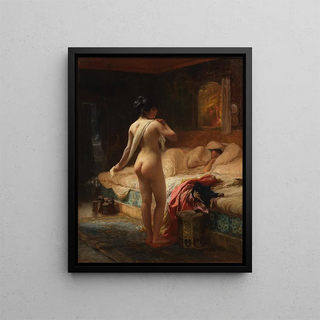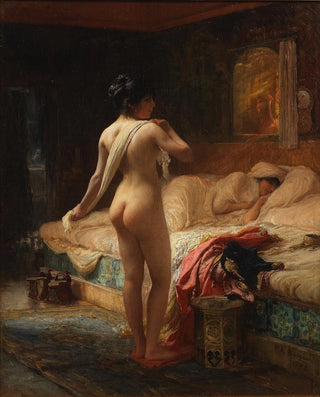Painting After the Bath - Frederick Arthur Bridgman | Art print Source: Tableau Après le bain - Frederick Arthur Bridgman | Reproduction


View from behind

Frame (optional)
Reproduction After the Bath - Frederick Arthur Bridgman – Captivating Introduction
The artwork "After the Bath" by Frederick Arthur Bridgman is a true ode to beauty and intimacy. This painting, which evokes the tenderness of a moment of rest after the bath ritual, immerses the viewer in a universe where light and color intertwine to create an atmosphere that is both serene and enchanting. Bridgman, whose talent lies in capturing the nuances of everyday life, invites us to share a suspended moment, where feminine grace is delicately highlighted. It is a piece that does not merely depict a scene but transcends its boundaries to offer a rich and immersive sensory experience.
Style and uniqueness of the work
Bridgman's style is distinguished by his mastery of lighting and textures. In "After the Bath," the soft light emanating from the scene highlights the delicate skin of the female figure, while playing with reflections and shadows. The drapery, carefully painted, seems almost tangible, inviting the eye to explore each fold and nuance. The artist uses a palette of warm, natural colors that evoke tranquility and harmony. This chromatic choice, combined with a balanced composition, gives the artwork an atmosphere of peace and timeless beauty. The attention to detail, whether in decorative elements or in the expression of the figure, reflects a deep respect for the subject and an exceptional craftsmanship.
The artist and his influence
Frederick Arthur Bridgman is an emblematic figure of the Orientalist movement, an artistic current that captivated many artists in the 19th century. His journey to North Africa profoundly influenced his work, allowing him to incorporate diverse cultural and aesthetic elements. Bridgman skillfully marries the sensuality of the human figure with elements of lush nature, creating compositions that speak to the soul. He fits into an artistic tradition that values beauty and exoticism, while bringing his own vision, marked by a unique sensitivity. His impact on Orientalist art is undeniable, and his works continue to inspire

Matte finish

View from behind

Frame (optional)
Reproduction After the Bath - Frederick Arthur Bridgman – Captivating Introduction
The artwork "After the Bath" by Frederick Arthur Bridgman is a true ode to beauty and intimacy. This painting, which evokes the tenderness of a moment of rest after the bath ritual, immerses the viewer in a universe where light and color intertwine to create an atmosphere that is both serene and enchanting. Bridgman, whose talent lies in capturing the nuances of everyday life, invites us to share a suspended moment, where feminine grace is delicately highlighted. It is a piece that does not merely depict a scene but transcends its boundaries to offer a rich and immersive sensory experience.
Style and uniqueness of the work
Bridgman's style is distinguished by his mastery of lighting and textures. In "After the Bath," the soft light emanating from the scene highlights the delicate skin of the female figure, while playing with reflections and shadows. The drapery, carefully painted, seems almost tangible, inviting the eye to explore each fold and nuance. The artist uses a palette of warm, natural colors that evoke tranquility and harmony. This chromatic choice, combined with a balanced composition, gives the artwork an atmosphere of peace and timeless beauty. The attention to detail, whether in decorative elements or in the expression of the figure, reflects a deep respect for the subject and an exceptional craftsmanship.
The artist and his influence
Frederick Arthur Bridgman is an emblematic figure of the Orientalist movement, an artistic current that captivated many artists in the 19th century. His journey to North Africa profoundly influenced his work, allowing him to incorporate diverse cultural and aesthetic elements. Bridgman skillfully marries the sensuality of the human figure with elements of lush nature, creating compositions that speak to the soul. He fits into an artistic tradition that values beauty and exoticism, while bringing his own vision, marked by a unique sensitivity. His impact on Orientalist art is undeniable, and his works continue to inspire
12,34 €






